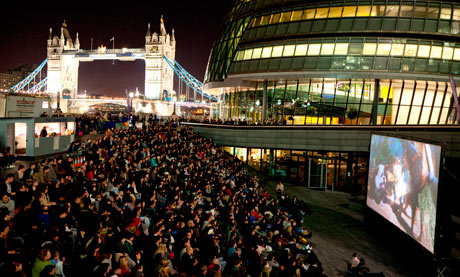
Free entertainment
In summer London is one big, novelty playground, as outdoor screens and live entertainment pop up in the most unlikely places. (2012 saw an east-end flyover and a mound of fridges co-opted into impromptu film theatres.) Most events charge and need pre-booking, but head to The Scoop beside City Hall for a summer-long programme of film screenings, dance, opera, music and even keep fit classes, all for free and alfresco beside the Thames.
• morelondon.com
Lesser-known viewpoints
Most guides would recommend Primrose Hill or Parliament Hill in north London for sumptuous views of the capital, but these are sometimes spoiled by the sheer number of visitors. Head south and you'll find bewitching outlooks from One Tree Hill at the quieter, eastern end of Greenwich Park. Be sure to explore the wider park while you're there, including the deer pens to the south. Even more off the beaten track is Stave Hill and ecology park on Dock Hill Avenue in Rotherhithe, SE16, built on the rubble of former docks. It provides views of Canary Wharf and the City.
• royalparks.org.uk, urbanecology.org.uk/stavehill.html
Revisit the Olympic Park
One year on, the Olympic Park is transforming into the Queen Elizabeth Olympic Park, one of the largest urban parks created in Europe for 150 years. While the area around the stadium and aquatics centre is still undergoing redevelopment, the northern parklands are set to open at the end of July. You'll also be able to visit the Copper Box, which hosted handball and other sports during the Games, and is now a flexible events venue and cafe.
• queenelizabetholympicpark.co.uk
Hampstead Heath pergola
The West Heath area is much quieter than the famous hills and woods of the main park. Nestled among the trees is one of London's most unexpected and serene discoveries. The Italian Pergola and Hill Garden is a sprawling complex of walkways, terraces and gardens, culminating in a spectacular view towards Harrow on the Hill. A little further west, Golders Hill Park contains a small (and free) zoo with wallabies and deer.
• Entrance off North End Way, NW3, hampsteadheath.net
Ping-pong
London has long had an affinity for table tennis. The game was first patented here 110 years ago: the location, in Holborn, is now occupied by a bat-and-ball-themed bar called Bounce. Mayor Boris Johnson famously resurrected the game's old nickname of whiff-whaff. And during a presidential visit, David Cameron challenged Barack Obama to a game. Fitting, then, that numerous free outdoor tables can be found around the city. The most central are in Cavendish Square and Regent's Park.
• Table locations at pingpongengland.co.uk
Rose garden
Regent's Park needs little introduction, but fewer people discover the most beautiful section: Queen Mary's Gardens at the heart of the Inner Circle. During the summer, it's a riot of colour. An estimated 12,000 rose bushes, often with bizarre variety names like Pensioners Voice and Ice Cream, vie for your attention. Nearby, a quiet lake and sculpture park are havens for wildlife, including black swans and bolshy squirrels.
• royalparks.org.uk
Explore an abandoned rail route
The Parkland Walk is one of London's little-known pleasures. It's effectively a linear park, following the Capital Ring walking route from Finsbury Park to Highgate (both easily accessible by tube) along an abandoned railway line. Along the way, you'll find the crumbling remnants of old stations, a creepy sculpture of a green man, and plenty of wildlife. Those with strong legs can follow an additional spur from Highgate up to Alexandra Palace, for spectacular views of north London.
• parkland-walk.org.uk
Walk the Roman walls
Most traces of Roman Londinium, founded 2,000 years ago, are long vanished, but you can still find fragments. Start by the Tower of London, where a statue of emperor Trajan guards the tallest section. From here, head north along Cooper's Row, and into the plaza of the Grange City Hotel. This is home to the most impressive section of wall, including an arch you can walk through. From here, take an anti-clockwise stroll around the Square Mile, looking out for further survivals along aptly named road London Wall, especially near the Museum of London.
Magnificent Seven cemeteries
The so-called Magnificent Seven cemeteries were created in Victorian times to cater for London's rapidly growing (and dying) population. Any of the seven is worth a visit for glorious monuments and secluded walks (although the most famous, Highgate, has an entry charge). Kensal Green cemetery off Harrow Road, W10, is easily reached by tube and offers occasional tours of the catacombs. Brompton Cemetery, in the shadow of Chelsea's football ground, is also beguiling. The others are at Abney Park in Stoke Newington, Nunhead, Tower Hamlets and West Norwood,
• royalparks.org.uk, kensalgreencemetery.com
City farms and other wildlife
London has over a dozen inner-city farms, where children can pet goats, feed cattle and oink along with the pigs. Spitalfields Farm is the closest to the centre. It is open all year round, and is particularly famed for its annual Oxford-Cambridge Goat Race each spring. Kentish Town Farm and Vauxhall City Farm are also close to the centre, but Mudchute Farm on the Isle of Dogs has the best views, with the towers of Canary Wharf forming an unlikely backdrop to the sheep pens.
It's also possible to see unexpected creatures without going to a farm. In Richmond Park, to the south-west, you'll hear the screeches of bright green parakeets, thought by some to be the descendants of birds that escaped the set of The African Queen, at the former Isleworth Studios, just over the river. You can often spy terrapins paddling along the River Lea in east London, and central London has a surprising number of nesting peregrine falcons. Look up to the balconies of the taller buildings.

